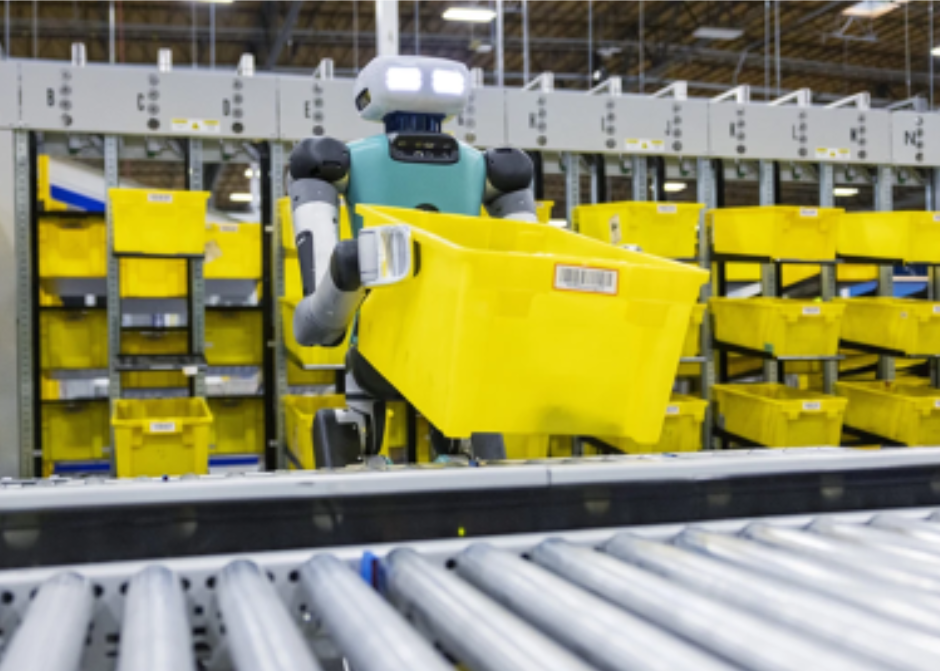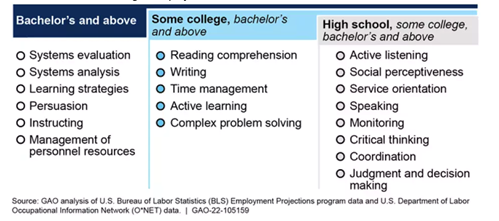Artificial Intelligence and the Next Generation Economy
The second in a three-part series on the origins and influences of Artificial Intelligence in education
4/15/2024

By Dr. Connor Oswald
John Adams, the 2nd President of the United States, once wrote:
"I must study politics and war so that my sons may have liberty to study mathematics and philosophy. My sons ought to study mathematics and philosophy, geography, natural history, naval architecture, navigation, commerce and agriculture in order to give their children a right to study painting, poetry, music, architecture, statuary, tapestry, and porcelain."
Since the creation of the Sabbath, the work week was six days long with one day of rest.
In the early 20th century, Henry Ford, the UAW, and Franklin D. Roosevelt declared one more day of rest. In 1930, John Maynard Keynes opined that by 2030, people would work only 15 hours per week. While the British economist was correct that there would be more leisure hours (the UK saw a 58% increase between 1931 and 2011) in the United States, we continue to work more than Europe, with leisure time being dominated by the retiring middle classes. But is all that about to change? Will Keynes’s temporal abundance finally make us relax?
Replacement of Logistics:
Walmart seems like an unlikely place to find the state-of-the-art logistics tools; however, its supply chain technology allowed the behemoth to scale from one store in 1962 to more than 10,000 retail locations in just over 60 years, bringing in more than $600 billion in revenue. What is the company’s largest cost? As the world’s largest employer, just behind the U.S. and Chinese military, it is labor cost, which is just a fancy way of saying paying for a person’s time.
The familiar face of Walmart might be the elderly greeter, the friendly cashier, or the stocker that helps us find some tool, t-shirt, or toy but that is only the last mile that a product takes to get into your hands. Before then, an army of people, trucks, trains, ships, and all the associated operators also touch it through the supply chain. I am not being hyperbolic when I say the race is underway to reduce the cost at every available avenue. The automation of fulfillment centers and distribution centers is a competition between Walmart and the next greatest logistics corporation, Amazon. Amazon’s new robotic solutions, Sequoia and Digit, will support workplace safety with hopes to help Amazon deliver to customers faster.
Automation looks different depending on who you ask but the experts at the GAO and the Department of Labor suggest that jobs with the following characteristics may prolong individuals from becoming unemployed:

Replacement of Fast Food and Retail:
Often bullied as “unskilled” labor for the repetitive tasks they are required to perform, employees at chain restaurants and customer facing retail stores have built a thick skin from dealing with uncouth customers’ belittling. Some trends in automation may relieve many from the burden of an irate and irrational client. Chipotle is on the forefront of this automation process. Expressly for delivery clients, the firm is experimenting with a completely automated robotic process that measures and doles out portions to the gram. This may improve efficiency as it frees up employees to focus on the customer experience of the clients in the store.
Chipotle’s model relies on automation on the composition side of a fresh product, but Panda Express is looking into the design and manufacture of a product that reduces skilled labor costs. The AutoWok allows an operator to save energy creating bulk dishes like its Chow Mein as it flips, turns, and prevents scorching. In the long run, this promotes consistency in the final product, improves the health outcomes as it reduces physical stress, and could possibly be looked at as a way to diversify the workforce as it reduces the strength requirement to cook large portion sizes. A homemade version will only set you back the price of a stove.
As Chipotle and Panda express work to automate the preparation of food in unique ways, the Japanese outfitter Uniqlo has quietly removed the direct need for store clerks in the automation of the retail checkout process. Using Radio Frequency ID(RFID) chips, all the customer needs to do is set down their purchase into the scanning bucket and the system will automatically tally the overall cost, no need to scan each individual item! Further, Computer Vision is the concept that if you give a computer a camera, it can it determine what is in its field of view. We are not far off from having a visual point of sale, or as Amazon has prototyped, will do away with a check-out line completely. As computer systems, whether they rely on RFID, computer vision, or just let you walk out of the store completely, replace traditional means of commerce, jobs that exist today will not exist tomorrow.
Replacement of Professionals with AI: Shrinks, Lawyers, Researchers and Artisans and Middle Management
Alan Turing, preeminent computer scientist and cryptographer of WW2 fame, developed the criteria for determining if a computer was “thinking.” The imitation game, as he called it, consisted of a computer and two persons. The interrogator is allowed to ask the computer and the other human subject questions, and ultimately make a decision on which respondent is the program and which is the human. Passing the test requires indistinguishability between responses. In the 1970s, programmer and AI pioneer Joseph Weizenbaum updated the test by programming Eliza, a psychotherapist chatbot that would restate the feelings a chat participant would make in the form of a question, a technique used regularly in therapy.
ChatGPT has guardrails for direct medical engagement, but as the cost of medical care continues to rise, the market for a judgment-free confidant that just so happens to take the form of a computer might be feasible for the right person. Psychiatrists are doctors who specialize in mental health. They diagnose and treat mental disorders, such as depression, anxiety, and schizophrenia. But how far are we away from having chatbots beginning to diagnose mental disorders and to provide therapy or escalations to preventative care? For example, the AI-powered chatbot Woebot is being used to treat depression and anxiety.
Lawyers are professionals who provide legal advice and representation. They draft contracts, negotiate deals, and represent clients in court. Except that when they review contracts, they’re only as good as how much sleep or caffeine they have had. They also need an exorbitant amount of time to read mind numbingly dull and repetitive print. AI is already being used to automate many legal tasks, such as contract review and legal research. For example, the AI-powered legal research platform Lawgeex is being used by law firms to automate contract review. Taking an average 90 minutes, 20 experienced lawyers were tasked with finding 30 legal issues with five non-disclosure agreements; they scored an average accuracy rate of 85%. Comparably, Lawgeex AI system completed the review in .4% of that time (in 26 seconds) with a 95% accuracy rate.
To provide a few more examples:
- Researchers and Data Scientists will be able to rely on supercomputing AIs like Watson for scientific discoveries or even just better business analytics
- Artisans will be able to accelerate their creation and their creativity via Dalle-3, Photoshop AI, and the next generation of tools for architecture, design and manufacturing.
- Middle management professionals will be able to use AI agents to set goals, delegate tasks, organize and deliver feedback.
- Tools like ShiftUp allow agile team managers to develop meaningful metrics and enable faster development sprints.
AI has the potential to accelerate the economy at all levels, mundane and repetitive tasks will be engineered out of existence leaving many with the question: how do we fill our time?
John Adams, Luddites, Shokunin
John Adam’s proposal sticks with us “to give their children a right to study painting, poetry, music, architecture, statuary, tapestry, and porcelain.” On its face, it seems unreasonable that the future of labor is an automated one and that human overseers provide feedback for a fleet of robots with the capacity to talk, or programs that rapidly assess complex documents and provide next steps for another agent to complete, but it's the one we live in. Get used to it.
The Luddites were a group of English textile workers who protested the introduction of new labor-saving technologies in the early 19th century. They believed that these technologies would lead to unemployment and poverty, and they destroyed machinery to prevent their use. Philosophically, they were influenced by Thomas Malthus who predicted the end of society after 1798 based on logarithmic growth of population and a linear growth in the food supply. Both Malthus and the Luddites were wrong because their pessimism was rooted in scarcity and not abundance. What will you do with your abundance?
Alongside the concept of Kaizen, Toyota’s manufacturing principle of continuous improvement, we may want to import the idea of the Shokunin. The direct translation of Shokunin from Japanese to English is “craftsman,” or “artisan.” Its meaning is substantially deeper, it, “‘implies an attitude and social consciousness. … The shokunin has a social obligation to work his/her best for the general welfare of the people. This obligation is both spiritual and material, in that no matter what it is, the shokunin’s responsibility is to fulfill the requirement.” — Tasio Orate.” To realize the founding fathers’ dream in the era of AI abundance is to follow Walt Disney’s Maxim, “Whatever you do, do it well…”